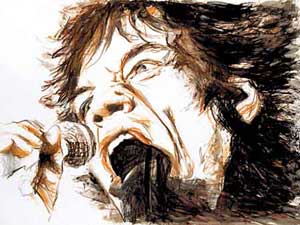Rock Music: The forgotten Child of High-End Audio


 A common complaint to the editors of audio magazines, especially from younger readers, concerns the paucity of rock music1 used in reviews of audio gear. While the use of rock music is not as rare as some make it out to be, it seems fair to say that rock plays less of a role than certain other musical genres, in particular jazz and classical. In a similar vein, upon returning from the Rocky Mountain Audio Fest 2007, a friend of mine complained about how few rooms used rock music to demo their gear, a complaint that is certainly valid. As such, I thought it would be of some interest to explore this phenomenon.
A common complaint to the editors of audio magazines, especially from younger readers, concerns the paucity of rock music1 used in reviews of audio gear. While the use of rock music is not as rare as some make it out to be, it seems fair to say that rock plays less of a role than certain other musical genres, in particular jazz and classical. In a similar vein, upon returning from the Rocky Mountain Audio Fest 2007, a friend of mine complained about how few rooms used rock music to demo their gear, a complaint that is certainly valid. As such, I thought it would be of some interest to explore this phenomenon.
[1 As is the case for all genres of music, “rock music” is somewhat ambiguous in that there is no absolute definition of what it encompasses. Moreover, the nature of rock music changes with time. In this essay, rock music will be used in a broad, inclusive sense.]
The explanation most often bandied about is that audiophiles are snobs who look down their noses at rock music, and at those who listen to it. While audiophiles most assuredly are elitist, I do not believe this is the explanation, at least not a sufficient one. For one thing, music selections at audio shows tend to be dominated by the recording de jour, which as often as not is a “chick with a guitar” (or piano, as the case may be) – hardly the stuff of elitism. Moreover, most audiophiles I know do listen to rock music, and I have never encountered a single individual who made any effort to hide this fact.
One plausible explanation has to do with demographics. Generally speaking, rock music is most popular with younger audiences, while audiophiles tend to be somewhat older. The lack of young audiophiles is due in part to a lack of exposure to high-end gear, but also to the costs; audiophile gear can be rather pricey, often out of the reach of those just starting a career, and perhaps a family. This disparity will invariably lead to some conflict between the musical tastes of younger audiences, and the majority of audiophiles (including reviewers and show exhibitors).
Another reason has to do with the quality of the recordings. As we know, poor recordings can often sound worse on a high-end system than they do on a less revealing system. Regrettably, rock recordings often have the most severe dynamic compression of all genres (often intentionally so, so they will sound okay in cars and on boom-box-type systems), thus making them poor candidates to evaluate or demonstrate a high-end system.
It has been suggested that reviewers and show presenters avoid rock music because their systems are not up to the task. While the demands for all types of music overlap considerably, each has its own particular requirements. As all systems reflect compromise, it stands to reason that some systems will be better for rock music than others. What are the requirements for rock music? I find it telling that when reviewers ask whether a system “can rock” they are usually asking whether it play loudly, with a minimum of distortion. Not surprisingly, many smaller speakers don’t excel in this test. Small speakers similarly have difficulty with the powerful bass lines that typify much rock music.2 All in all, there may well be some truth to the idea that rock music is avoided because many systems simply can’t do it justice.
[2 In terms of audio shows, it should be kept in mind that playing bass-heavy music at near-ear damaging levels is not the most neighborly practice.]
Another way to express this is to say the music selected for reviews and demos is that which best serves the gear. For reasons I don’t quite grasp, this is often spoken of as if some great conspiracy, another example of the nearly limitless list of things which enrage audiophiles. Call me naive but I view it as putting one’s best foot forward, an approach which many healthy individuals use in both their personal and professional lives.
In light of small speakers’ obvious limitations, why do audiophiles buy them? There are of course the logistical reasons including cost, space, room size and spouse acceptance factor. There are also the advantageous sonic attributes, such as the ability of small speakers to more effectively ‘disappear,” and the superior coherence from a speaker using fewer drivers. But this brings us to the next point – yes, there really is a point: While it is true that rock music may at times be avoided because it doesn’t properly show off the gear, the flip side of the coin is equally true, wherein certain music is chosen because the gear best serves it. By this I mean that some types of music benefit more than others from a high-end audio system.
How so?
Consider live performances. Jazz is typically performed in small venues, many of which have, in my experience, reasonable acoustics. During a performance the audience is silent or at the least, quiet. If amplification is used, it is often minimal. The situation is more extreme with classical music. While the venues are typically larger than those for jazz, they are often designed with exquisite attention to acoustics (admittedly, with varying results). During a performance the audience is usually dead-silent; they are there to listen, and nothing should interfere with that objective. Contrast that with rock concerts. Often as not these are held in enormous venues – those with capacities in the tens of thousands – the acoustics of which are, sadly, often terrible. During the performance the audience often stands (sometimes on their seats), dances in the aisles, and hoops, hollers and screams at the top of their lungs – often during the best riffs – to say nothing of diving off the stage into the audience. Lest this be taken as an indictment of rock music, let me assure you it is not. Rock music is an incredible art form, both for the social message it imparts and for the raw, unbridled energy and passions it elicits. That said, it is apparent that the experience of listening to rock music differs from that of listening to other genres, and in my experience this extends to listening to recorded music as well. While it is true that many – if not most – of the recordings we listen to are not of “live” performances, the basic ways in which we listen are the same. So what does this have to do with the choice of music for system evaluation?
As I see it, many of the characteristics we associate with high-end audio – midrange purity, portrayal of acoustic space, a sense of instrument “body,” and the ability to convey subtlety, nuance, and the correct rhythmic flow of the music – are more closely linked to the jazz and classical experience than they are to rock music. One obvious explanation for why this is so, is that rock music generally uses “electric” instruments whereas jazz and classical the others do not. This is especially relevant with string instruments because – at least to my ear – electronically amplifying instruments masks, to varying degrees, the delicateness and texture of the bowed or plucked strings, as well as the fullness and richness of instrument’s wooden body. Thus, much of what high-end audio – as defined above – brings to the table is lost with rock music.
Moreover, as described above, the jazz and classical listening experience differs considerably from that of rock. The delicacies (for want of a better term) of the instruments seem to matter much more for jazz and classical, than for rock, for which the raw emotion seems to predominate. This is of course a generalization, as there are many elements shared between all types of music. Nor do I mean to suggest that rock music does not sound better on a top-notch system – – of course it does – – only that the subtleties and harmonic structure that high-end audio brings to the table are more important for jazz and classical, whereas rock music’s needs are simpler, tending toward more raucous systems.
Concluding Remarks
The popularity of iPods and home theater, and general changes in how people listen to music, have all contributed to hard times for audiophilia. It is well known that we audiophiles are – dare I say it? – an aging population, and that the survival of the hobby is dependent on bringing in new – and younger – blood. One common suggestion for achieving this goal is for magazines (print and on-line) to review sanely-priced gear. Despite claims to the contrary, analyses have shown that many publications – print and electronic – are doing precisely that. A second approach to bringing in a younger audience is to have rock music (as well as other genres of modern music) play a more significant role in reviews and auditions/demonstrations. As such, exploring the contribution of rock music is of more than academic interest. As I have endeavored to show in this short essay, there are sound (pun intended) reasons why rock music has been relegated to second-class status in the audiophile community. What exactly should we do about it? My suggestion is that we keep an open mind, be cognizant of the fact that musical tastes vary considerably amongst music lovers, and make a concerted (ouch!) effort to accommodate the tastes of all who express an interest in our hobby.
Rock on!

![]()
Don’t forget to bookmark us! (CTRL-SHFT-D)
Stereo Times Masthead
Publisher/Founder
Clement Perry
Editor
Dave Thomas
Senior Editors
Frank Alles, Mike Girardi, Russell Lichter, Terry London, Moreno Mitchell, Paul Szabady, Bill Wells, Mike Wright, and Stephen Yan,
Current Contributors
David Abramson, Tim Barrall, Dave Allison, Ron Cook, Lewis Dardick, John Hoffman, Dan Secula, Don Shaulis, Greg Simmons, Eric Teh, Greg Voth, Richard Willie, Ed Van Winkle, Rob Dockery, Richard Doran, and Daveed Turek
Site Management Clement Perry
Ad Designer: Martin Perry





Be the first to comment on: Rock Music: The forgotten Child of High-End Audio